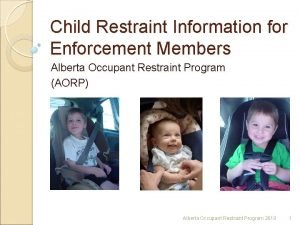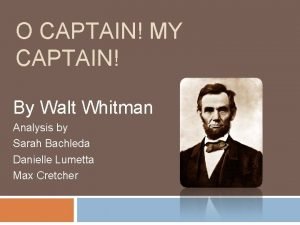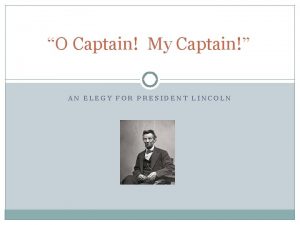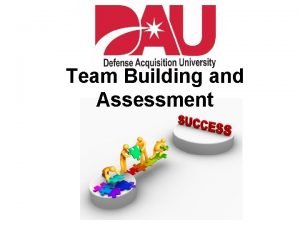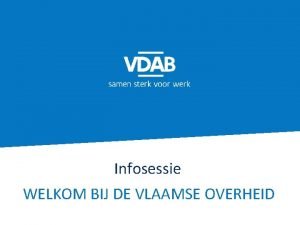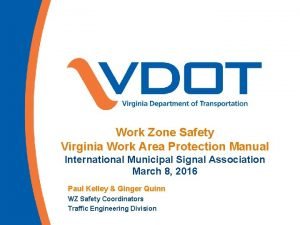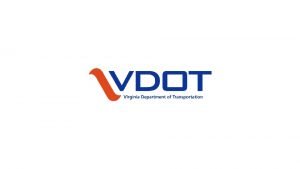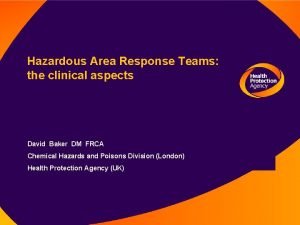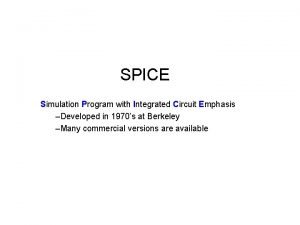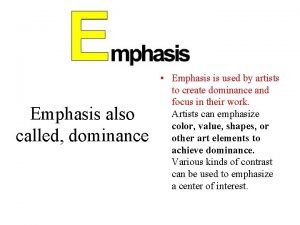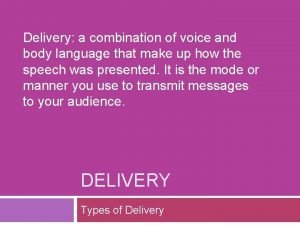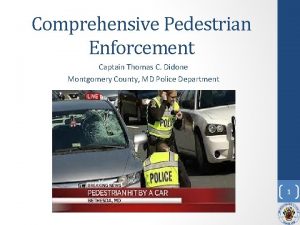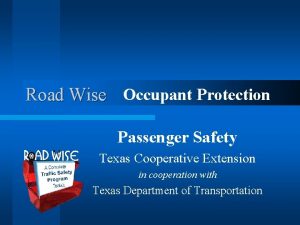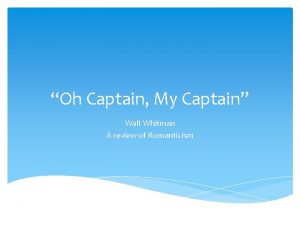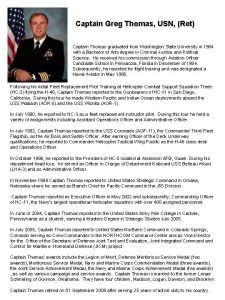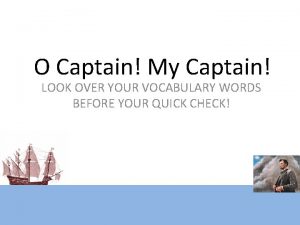Occupant Protection Emphasis Area Team Captain Tom Didone






















- Slides: 22


Occupant Protection Emphasis Area Team Captain Tom Didone, Co-Chair Montgomery County Police Department Christina Utz, Co-Chair (Suzy Solo Acting) MDOT Maryland Highway Safety Office

Why do we care? • People continue to needlessly die in traffic crashes solely because they did not wear their seatbelts or properly restrain their children in the vehicle. • Too many officers continue to not wear their seatbelts because they believe the myth that they cannot “catch the bad guy” or survive an ambush situation with their seatbelt on. • In our quest “Towards Zero Deaths” the only compliance rate that is acceptable in Maryland is 100% for all occupants.

Maryland CIOT Video

Data • Occupant Protection remains a serious safety problem on Maryland Roadways. • The overall seat belt use rate in the NHTSA-weighted jurisdictions has increased from 92. 1% in 2014 to 92. 9% in 2015. • Between 2009 - 2013 unrestrained motor vehicle occupant protection fatalities on all roads in Maryland averaged 116 per year and serious injuries averaged 315 per year. • Between 2009 – 2013 there were a total of 78, 521 people identified in a crash who were seating positions 4 -6 (back seat). Of those 10, 512 were reported to be unbelted (13%). • There were a total of 125 back seat fatalities of which

Myth Busters Video

Seatbelts • Mandated for both front and back seat passengers • Proven technology that works after driver makes a mistake. • Must be worn correctly in order to rid down the crash and minimize injury. • Works in conjunction with but not in place of airbags

Airbag Demo Video

Air Bags Deploy at approximately 200 mph On-board computer determines if deployed Will cause injury if occupant is not belted A good reason to not ride with your feet on the dash • Small children and infants should never ride in the front seat • •

Rear Seat Passengers • Are seatbelts really necessary for passengers who ride in the rear passenger compartment of a vehicle?

Back Seat Crash Video

Dufief Mill Road / Quince Orchard Road • June 25, 2015 • Single vehicle driving on the wrong side of the road, swerved back, went off the road, went through a culvert and went airborne. While airborne, the vehicle struck two trees before rolling over completely. Vehicle landed on its roof and slid to final rest. • Vehicle speed prior to losing control: 65 mph (35 mph zone). • Driver and Front Passenger Survived, 2 Rear Passengers Deceased.

Calvin & Alex

We Need Your Help

EA Team Structure and Organizations • Who we are: – One of six volunteer teams supporting the implementation of the Maryland State Highway Safety Plan – Government (Federal, State, Local, and Municipal) and non-government organizations dedicated to reducing traffic fatalities and injuries – Representative members: • Maryland Department or Health and Mental Hygiene, Maryland Department of Transportation, Maryland Institute for Emergency Medical Services Systems, Local Law Enforcement Agencies, University of Maryland, Johns Hopkins University • What we do: – Developed strategies and action steps designed to increase seat belt usage to be implemented by our member agencies and organizations – Conduct quarterly meetings to discuss progress, issues encountered, and to discuss future steps – Discuss taking on new initiatives and adding action steps

Recruitment and Engagement • The Occupant Protection EAT Strategies – Improve the timeliness, accuracy, completeness, uniformity, accessibility, and integration of occupant protectionrelated data. – Enhance and improve enforcement of adult and child occupant protection laws – Implement adult and child occupant protection public awareness and education, training, and media campaigns. – Evaluate and recommend legislation and/or regulations to advance occupant protection for all ages

Strategy 1 • Improve the timeliness, accuracy, completeness, uniformity, accessibility, and integration of occupant protection-related data. – Action Item 1. 1: Establish a data exchange interface to push e-ticket and ACRS information and share this data with Maryland counties and municipalities. – Action Item 1. 2: Review ACRS definitions to standardize definitions (such as the definitions of occupant protection and unrestrained occupants) and review ACRS fields to ensure that are fully consistent with requirements. – Action Item 1. 3: Review current safety equipment use data to determine if the data has sufficient detail to support assessments of risk factors and fatality/accident rates by driver age and occupant protection subgroup and develop any necessary recommendations to support improved data collection. – Action Item 1. 4: Provide law enforcement with statistics demonstrating how occupant protection enforcement reduces fatalities and injuries – Action Item 1. 5: Evaluate the effectiveness and impact occupant

Strategy 2 • Enhance and improve enforcement of adult and child occupant protection laws. – Action Item 2. 1: Conduct high visibility day and night seatbelt enforcement (such as Click It or Ticket) on a year-round basis. – Action Item 2. 2: Provide state-wide training for law enforcement personnel on enforcement of occupant protection laws and best enforcement practices. – Action Item 2. 3: Work with Maryland’s Chiefs of Police and Sheriffs to develop a model occupant protection enforcement policy for all law enforcement agencies that promotes occupant protection enforcement as an enforcement priority. – Action Item 2. 4: Conduct current seat belt use surveys to include backseat belt usage as feasible. – Action Item 2. 5: Encourage state, municipal and local enforcement and other personnel to utilize occupant protection devices, as appropriate, when operating government-owned

Strategy 3 • Implement adult and child occupant protection public awareness and education, training, and media campaigns. – Action Item 3. 1: Seek new partnerships among social and traditional media outlets to expand Occupant Protection and Child Passenger Safety messages to the public. – Action Item 3. 2: Identify and implement components of relevant National Occupant Protection and Child Passenger Safety Campaigns. – Action Item 3. 3: Develop and translate new, and revise existing Occupant Protection and Child Passenger Safety educational materials (print and video), and distribute as needed; ensure content materials are culturally relevant for public use and applicable to community partners (law enforcement, health care, high risk, faith-based, EMS, etc). – Action Item 3. 4: Increase awareness and technical training for the public (including caregivers, law enforcement, EMS/Fire, medical, child education, faith-based and community partners)

Strategy 4 • Evaluate and recommend legislation and/or regulations to advance occupant protection for all ages. – Action Item 4. 1: Review and compare Maryland’s occupant protection laws with other states to identify model language and best practices. – Action Item 4. 2: Work with the Office of the Attorney General to draft legislation supporting occupant protection enforcement for all drivers and passengers as a primary offense under Maryland law

Next Steps • Join and participate in an EA Team can help Maryland reduce fatalities and injuries • Provide us with your contact information on the sign in sheet and we will invite you to our next meeting • May meeting

Question and Answer
 Alberta car seat regulations
Alberta car seat regulations Contoh metode penerjemahan adaptasi
Contoh metode penerjemahan adaptasi O captain my captain is an elegy
O captain my captain is an elegy Rhyme scheme of the poem o captain my captain
Rhyme scheme of the poem o captain my captain Elegy o captain my captain
Elegy o captain my captain O captain my captain tpcastt
O captain my captain tpcastt O captain my captain poem analysis
O captain my captain poem analysis O captain my captain audio
O captain my captain audio Team emphasis
Team emphasis Captain of the 1964 top of the form team analysis
Captain of the 1964 top of the form team analysis Tomtom go 910 update
Tomtom go 910 update The devil and tom walker symbols
The devil and tom walker symbols Team tom vdab
Team tom vdab Virginia work area protection manual
Virginia work area protection manual Vdot wapm revision 2
Vdot wapm revision 2 Going native project management
Going native project management Team spirit becomes team infatuation
Team spirit becomes team infatuation The white team cheers for the blue team, just like
The white team cheers for the blue team, just like Hazardous area response team
Hazardous area response team Spice (simulation program with integrated circuit emphasis)
Spice (simulation program with integrated circuit emphasis) Focal point through placement
Focal point through placement Difference between dominance and emphasis
Difference between dominance and emphasis Delivery language in communication
Delivery language in communication
